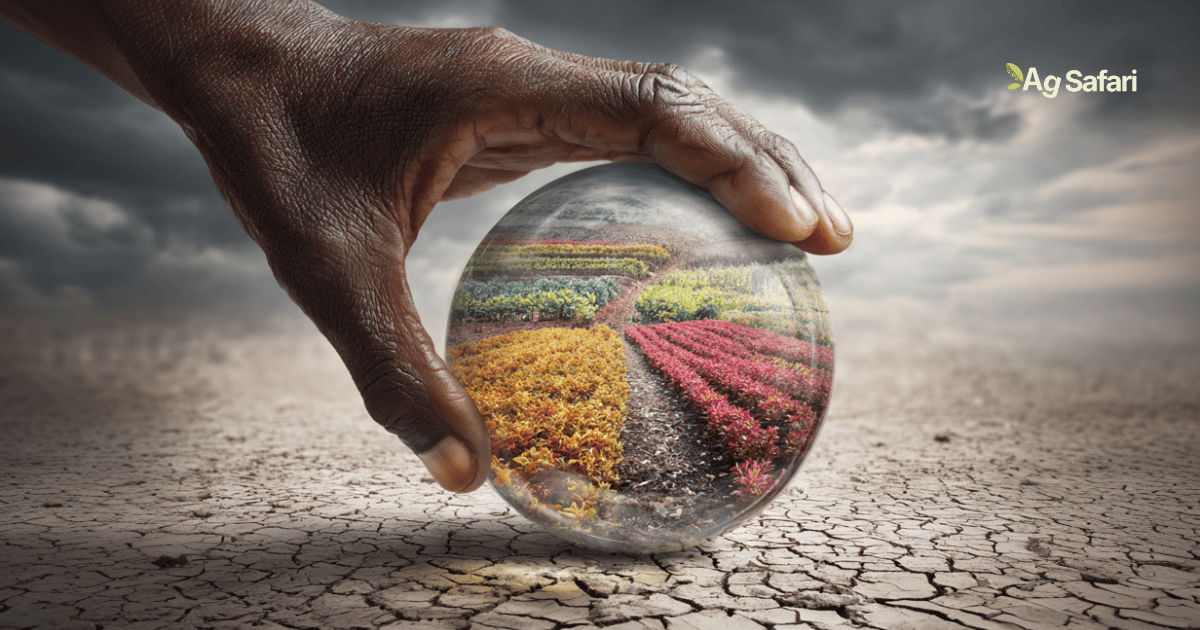Hey, Hannatu here 👋
African farmers lose about $68 billion annually to guesswork.
Across the continent, many farmers guess where to plant, how much fertilizer to use, and when to harvest.
And the cost is brutal: bad soil decisions alone slash 20–40% of harvests. millions of tons of That's millions lost in food.
And billions lost in income.
Nigeria has already lost $1.8 billion dollars to it.
And with climate change, the numbers are climbing higher.
Droughts hit harder. Rains come at the wrong times. And traditional farming wisdom no longer works for farmers.
When the old algorithm fails
Traditional wisdom says the rains in North Central Nigeria start in June.
So a farmer in Kwara State, smack in the North Central zone, plants maize in May and waits. But the rains don’t come until August
And by then, the farmer’s entire season is lost.
This story repeats across the continent.
In Kenya, coffee farmers face unpredictable rainfall that disrupts their cycles and leads to crop failure.
In Ghana, cocoa farmers deal with soil erosion which has been caused by consistent, unpredictable rains.
They no longer are sure of where to plant, and and when.
For decades, farmers have depended on traditional farming wisdom.
Planting and harvest followed a rhythm they could trust. Where and when to plant, how much fertilizer to use, and when to harvest.
Unfortunately, with climate change, traditional farming wisdom is failing. African farmers now lose about $68 billion annually to guesswork.

A Nigerian farmer who lost her entire yield to flooding. Photo Credit: BBC/Gift Ufuoma
They also lose about 50 million tons of food annually. That's enough food to feed 200 million people simply vanishing.
Beyond food loss, this drives up prices and contributes to growing food insecurity. In Nigeria, a bag of maize that cost ₦6,500 ($4) went as high as ₦75,000 ($50) due to smaller harvests.
For small farmers living on less than $2 a day, one failed season can mean pulling children out of school, selling livestock, or even starvation.
For decades, farmers have been forced to farm blind.
But now, technology is giving them something they’ve never had before: vision.
Farming in full colour
It took Gabriel Eze 30 seconds to change a farmer's life.
Using a simple map on his phone, he calculated the exact farm size.
He also showed the farmer crop analysis. The green meant healthy areas. Yellow showed zones needing help. Red showed struggling sections.
"His eyes lit up," Gabriel remembers. "He pointed to a red area and said, 'This part always worries me.'"
Technology confirmed what the farmer's eyes had suspected.
Gabriel's company, Rural Farmers Hub, creates these "intelligent maps" for farmers.

RFH offers farmers intelligent maps. Photo Credit: Rural Farmers Hub
Satellites analyze soil nutrients and crop health. Farmers get color-coded reports showing exactly what to do.
The technology is surprisingly simple.
Farmers open a PDF on their phones. Or they find local agents to do so for them.
Each colored zone comes with clear instructions like what part of the farm needs more nutrients, what type of nutrients, how much to apply, and when to spread it.
"After one session, farmers start using our language. Dark green, light green, yellow. It becomes part of how they talk about their farms."
The results speak loudly.
Rural Farmers Hub has trained 140,000 farmers across Africa. They've provided soil analysis to 31,000 farms.

Reps from Rural Farmers Hub and Cornell University meet with smallholder farmers. Photo Credit: Techeconomy
One Nigerian farmer walked into a shop to buy urea fertiliser.
But the Rural Farmers Hub dealer suggested testing her soil first.
The analysis showed nitrogen was fine. But phosphorus was low.
She bought an NPK blend instead of urea. Four weeks later, she returned smiling. Her plants looked stronger. Colors were richer. Growth was more uniform.
One simple test saved her money. It gave her soil exactly what it needed.
The next challenge? Helping farmers see beyond the soil, and into the future of their harvests.
The future in hectares
Knowing what's in your soil is only half the battle.
For a farm to thrive, the owner needs to predict the outcome: the harvest.
This is what Tolbi, a Senegalese startup, does.
While Rural Farmers Hub focuses on soil health, Tolbi uses AI and satellites to predict yields and harvest timing. Their platform helps farmers through:
Yield predictions: telling farmers exactly how much crop to expect
Water monitoring: using drones and moisture sensors to track real-time needs
Harvest timing: suggesting optimal dates to maximize quality and price
Planning support: helping farmers know when to hire labor and how much storage they'll need.

One of Tolbi’s products, WOMA. Photo Credit: Tolbi
The goal is replacing farming guesswork with data-driven decisions.
Both companies solve the same core problem. They replace guessing with knowing.
A farmer in Nigeria consistently used the same fertilizer across his farm. Until he got better intel.
Now he splits his land into zones. Each zone gets customized treatment. He buys fewer fertilizer bags in some areas. Different products in others.
By harvest, his yields improved significantly.
"Once farmers see their farm in those colors, they stop guessing," Gabriel notes. "They finally know how to manage their land correctly. The economic impact is large.”
Farmers who use soil maps spend less and harvest more.Their costs drop by 15–30%. And their harvests? Up by 20–50%.
Smarter farming. Bigger returns.
For small farmers, these improvements change lives.
The future of African farming is precision
These startups show a broader trend. Precision agriculture is finally reaching smallholder farmers.
This means farming with exact knowledge instead of guesswork.
These startups use data to tell farmers exactly what each part of their field needs.
The approach relies on different types of data working together. Soil sensors measure moisture, temperature, and nutrients. Satellites track crop health from space. Weather stations provide forecasts.
This data gets processed into simple recommendations.
Instead of treating a whole farm the same way, farmers can personalise care for each zone.
The goal isn't just better farming. It's preventing food crises before they start.
In a continent where over 300 million people face hunger, precision agriculture matters.
Companies across Africa now use these tools to monitor crop growth. Track livestock movements. Predict weather patterns.
Gabriel sees a future where every African farmer accesses precision tools. These were once available only to large commercial operations.
"Whether you're in North Central Nigeria or anywhere in Africa, the process is the same," he says. "With just your coordinates, you can get insights."
Climate change isn't waiting for African agriculture to catch up.
But farmers aren't waiting either.
They're looking up to better see what's coming.
What would you do if you could predict your farm's future?
👉🏾Tell us here.
Cheers,

How are you enjoying Ag Safari so far?
Join Ag Safari
Ag Safari is the go-to newsletter for anyone curious about agricultural innovation and potential across Africa. Every week, we deliver tactical insights, news, and founder-led advice straight to your inbox.


